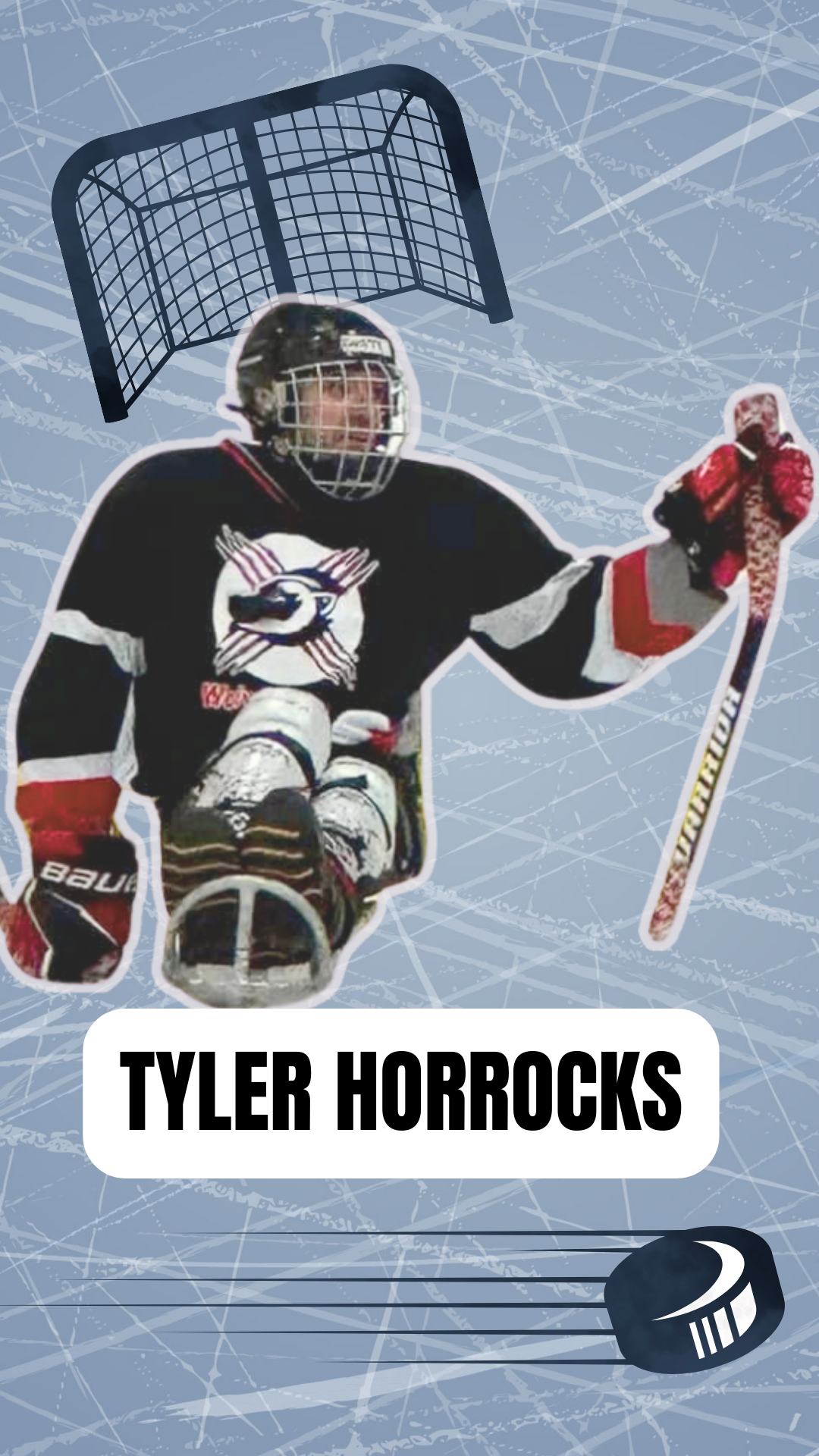Tyler Horrocks - Sledge Hockey Player
INFO: You may notice that in the below interview we used the term Sledge Hockey and Para Hockey to discuss the same sport. Para ice hockey is the term used to refer to the Para Hockey sanctioned sport version of ice hockey. The sport was added to the Paralympic Winter Games in 1994.
To participate in Para Hockey sanctioned events (i.e. Paralympic Winter Games, Olympics, etc) athletes must have an impairment of permanent nature in the lower part of the body of such a degree that it makes traditional skating and consequently ice hockey playing, impossible. The 2025 Para Cup in Dawson Creek is one of these sanctioned events.
Meet Tyler Horrocks
“I love to take on challenges,” says Tyler Horrocks. “Just because I have cerebral palsy doesn’t mean I can’t live a great life.”
Thirty-two-year-old Tyler Horrocks lives and breathes sledge hockey for the Wolverines Adaptive Sports Association (Grande Prairie). His cerebral palsy, present since birth, has meant adapting to challenges throughout his life. Cerebral palsy is caused by damage to the brain that disrupts the signals to muscles therefore impacting his legs — so he primarily uses crutches or a walker.
Tyler began playing sledge hockey in junior high school, and 2025 marks his 19th season in the sport. He was introduced to the game by a family member who discovered that Grande Prairie had a sledge hockey team. That connection suggested his family bring him out to a Sunday night practice — and the rest, as they say, is history.
Tyler fell in love with sledge hockey.
The first practice was intimidating. “It looked tough and difficult, and I was fairly nervous,” said Horrocks. He needn’t have worried — the club had sledges, equipment, helmets, and gloves to borrow, plus great people on hand to show him the ropes.
 “It was exciting to start,” said Tyler. “I have always tried to beat my disability and not let it slow me down. Just because I have cerebral palsy doesn’t mean I can’t have a great life.”
“It was exciting to start,” said Tyler. “I have always tried to beat my disability and not let it slow me down. Just because I have cerebral palsy doesn’t mean I can’t have a great life.”
An unintended but welcome benefit of playing sledge hockey has been an increase in upper body strength and the slower progression of his cerebral palsy. “Sledge focuses a lot on your back and your core/trunk. When I first began, balance was an issue because I didn’t have much trunk strength.” Beginners, he explained, start with the sledge blades widened to help with balance, but as skill improves, the blades are moved closer together. Wider blades mean better balance, but less maneuverability and more difficulty making sharp turns — it just takes time to adjust.
When ordering a personal sledge, players provide measurements such as body length, hip size, and whether a higher back is needed for support. Sledges are typically made from aluminum or steel frames with a molded plastic bucket seat. The frame is equipped with two skate blades that allow the sledge to glide on the ice, and straps secure the player’s feet, ankles, and hips for stability and proper positioning. Hockey sticks are generally around 33.5 inches long but can be customized. They feature a blade on one end for puck handling and a pick on the other for propulsion. Goaltenders may use a slightly longer blade and may also have an additional pick or trapper glove.
Tyler says playing for the Wolverines (Grande Prairie) has helped him grow as an individual. He participates in speaking engagements, facilitates sledge hockey demos for schools, and promotes the sport whenever he can. “I was quite a shy person before, but playing sledge and being part of the Wolverines has changed me. If I were to sit around and not do much, my cerebral palsy would get worse. The stronger I can stay, the better off I am.”
When asked about seeing top-ranked national teams in action at the Para Cup in Dawson Creek, November 30 – December 6, Tyler said: “I think it’s wonderful! Anything to support and promote sledge hockey is great. Sledge needs to be recognized more, and people need to learn about adaptive sports.”
Sledge hockey is inclusive for everyone. Many players on his recreational team are able-bodied individuals who have grown to love the sport. His team currently has 10–12 players, with more than half being able-bodied.
“Sledge is just another sport, like wheelchair basketball — you don’t need to have lower limb issues to participate,” explains Tyler.
Looking ahead, Tyler is eager for the 2025–2026 season with the Wolverines (Grande Prairie) and hopes they make it to the Western Canadian Sledge Hockey Tournament. Two years ago, the Wolverines (Grande Prairie) came home with a silver medal; last year, they earned bronze.
There are some upcoming opportunities to try sledge. If you are from the Grande Prairie area, check out the Wolverines Adaptive Sports Association (Grande Prairie) Facebook page to learn more about their club. Their season is starting soon and they have just put out the invitation to the public to come out and try adaptive hockey at the Design Works Centre, September 7th at 7:30 p.m.
If you live in the Dawson Creek area, there are three opportunities coming up for you to try sledge (Para Hockey) where you can learn the basics, hop in a sled and give it a try - all equipment provided.
Saturday, September 13th - Memorial Arena
Saturday, October 11th - Ovintiv Events Centre
Saturday, November 8th, Ovintiv Events Centre
All times 11:15 am - 12:45 pm
Drop In (first come, first served)
No experience necessary
Family friendly